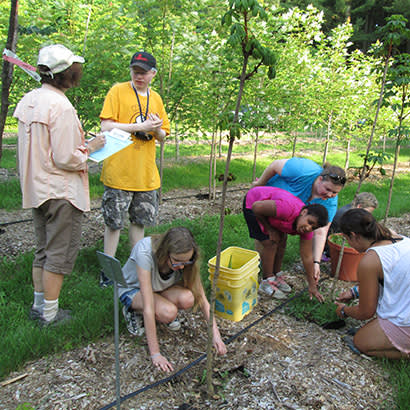
Each April brings not only Earth Day, but also Arbor Day — a holiday that while not as widely celebrated, holds equal importance. Many people are aware that trees are vital to the existence of humans, as well as wildlife and nature altogether. Some, however, may not realize that in addition to providing oxygen and clean air, trees serve numerous other functions that are critical to our daily lives. They combat climate change, conserve energy, stabilize soil, prevent water pollution, provide food, act as a home for wildlife, have healing effects on mental health — the list goes on.
In Burlington, Vermont, the city’s Parks, Recreation and Waterfront department staff works not only in April, but also year-round to increase the number of trees and the benefits they provide for the city’s residents. The department’s Trees and Greenways team consists of a full-time arborist and three full-time arborist technicians who care for 8,500 street trees, 3,100 park trees and 150 acres of forested parkland. Year-to-year, these numbers are consistently growing thanks to the work of dedicated park staff and help from volunteers.
In 1998, the Parks, Recreation and Waterfront department partnered with Branch out Burlington! (BOB!), a volunteer nonprofit, to establish a community tree nursery that provides trees for city parks and streets. According to the BOB! website, some of the benefits of a community tree nursery include:
- Reduced costs – while trees from commercial nurseries typically cost anywhere from $200 to $300, it costs approximately $100 to grow a tree in the nursery. Each year, the city of Burlington saves more than $20,000 by sourcing from the nursery.
- Better adjusted trees – trees that are grown in the area are more acclimated to the climate and environment and, therefore, are more likely to thrive once transplanted.
- Better variety – the ability to grow a greater variety of trees allows city arborists to better diversify the city’s plants to protect against mass destruction of tree populations from disease or pests, such as the emerald ash borer beetle that recently has been deemed a threat to Burlington’s trees.
- Community education and engagement – BOB! engages the public in the maintenance of the nursery, which teaches residents about the value of trees and fosters interest and investment in the long-term care of the plants that are ultimately placed in city parks and along city streets.
Each year, BOB! volunteers, with help from Parks, Recreation and Waterfront department staff, plant more than 150 trees in the community tree nursery. After two to three years, these trees are transplanted onto Burlington’s streets, growing Burlington’s urban forest. In 2016, parks department staff planted 141 new trees throughout the city. By 2019, that number had increased to 360 trees planted annually. These numbers reflect only the trees planted in city parks and along city streets. In addition, more than 3,000 restoration trees (young trees planted in natural areas) have been planted throughout Burlington.
To learn more about the city of Burlington’s efforts to bring the benefits of trees to its residents, visit the city of Burlington's website.
Lindsay Collins is Associate Editor for Parks & Recreation magazine.

